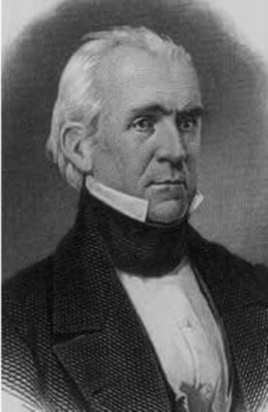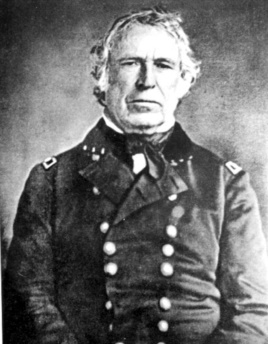VOA慢速英语:波尔克1848年当选总统
From VOA Learning English, welcome to The Making of a Nation, our weeklyprogram of American history for people learning American English. I’m SteveEmber, in Washington.
The Mexican-American war officially ended in 1848. Mexico agreed to giveCalifornia and New Mexico to the United States. And, Mexico would recognizethe Rio Grande River as the southern border of Texas.
 |
|
President James K. Polk |
Thus, President James K. Polk had succeeded inexpanding the United States. He had added Oregon,California, Texas, and New Mexico to the country. Now, the country faced the problem of what to do with slaveryin the new territories.
“As soon as it became clear in the Americanconsciousness that Polk’s aim in the Mexican Warwas to gain Southwestern territory—California andwhat’s now the American Southwest—then the slaveryquestion becomes very, very salient in a powerful waythat it had been kept under wraps for 20, 25 years.”
Robert Merry is an historian and the author of a bookabout James K. Polk.
“So we went through 10 years of kind of political hell inAmerica as we struggled through that issue, whichcould only be settled through force of arms.”
Southerners argued that they had the right to bringslaves into California and New Mexico. Northerners opposed any furtherspread of slavery. But the real question was a legal one. Did Congress havethe power to control or ban slavery in the territories?
Until Texas became a state, almost all national leaders seemed to accept theidea that Congress did have this power. For 50 years, Congress had passedresolutions and laws controlling slavery in U.S. territories. But Southern slaveowners believed the power to control slavery remained with the states. Thereseemed to be no answer to the problem.
While Congress debated the issue, the country moved quickly into thepresidential campaign of 1848. President Polk was old, tired and in poorhealth. He said he would keep his promise to serve only one term. Polk feltthat he had done his duty. During the first days of his administration, he listedthe goals of his presidency.
First, he wanted to reduce the tax on imports. Second, he wished to establishan independent treasury, which the Whigs, had voted out. Third, he hoped tosettle the Oregon border dispute with Britain. And fourth, he wanted to makeCalifornia part of the United States.
Less than four years later, he had succeeded with each item on his list. TheUnited States and Britain agreed on a compromise in the Oregon dispute. In 1846, Polk was able to establish the independent Treasury again, where thegovernment could keep its own funds. No longer would government moneybe kept in private banks.
That same year, Polk was able to get Congress to approve a bill that greatlyreduced the taxes on imports. And the peace treaty with Mexico gave theUnited States not only California, but also New Mexico. So, the presidentbelieved he had served his country well.
Polk, however, had not served his party well. He was not a good politician. He failed to unite competing groups within the Democratic Party. What wasworse, he let them move even farther apart.
There seemed to be no strong Democratic candidate who could unite theparty. At one extreme were the supporters of former President Martin VanBuren -- New York Democrats opposed to slavery. They were called"Barnburners." They got this name from their opponents, who claimed theywere willing to burn down the entire barn to remove pro-slavery rats.
At the party's other extreme were the Democrats of the South, led by John C.Calhoun of South Carolina. In every state, the Democrats were dividedbetween those who supported the Polk administration and those opposed to it.
Democratic delegates met in Baltimore in May of 1848 to choose theircandidate for president. On the fourth vote, the delegates chose SenatorLewis Cass of Michigan as the party's presidential candidate. Cass was 66years old. He was considered a moderate Democrat. He was a northernerwho did not oppose slavery.
On the question of slavery in the new territories, Cass believed that the peopleliving in those areas should make the decision. The Barnburner Democrats ofNew York refused to accept Cass as their candidate. They walked out of theBaltimore convention.
Senator Henry Clay of Kentucky expected to be the presidential candidate of the Whig Party. The Whigs had nominated Clay as their candidate in threeearlier elections. But Clay lost all three times. In 1848, older members of theparty still supported him. But young Whigs felt a new candidate was needed.
 |
|
Portrait of General Zachary Taylor. Taylor led American troops against Mexican forces. |
Some party leaders remembered how William HenryHarrison had won the presidency for the Whigs in 1840 by campaigning as a military hero. The country nowhad a new military hero: "Old Zach," General ZacharyTaylor. He and his men never lost a battle in theMexican War. Several times, General Taylor defeatedMexican forces much larger than his.
Taylor was 63 years old. He had almost no formaleducation. He had spent almost 40 years in the Westas an Indian fighter and commander of small armybases.
Some politicians did not believe Taylor had the ability to be president. But his supporters put great energy intotheir campaign. They tried to sell the idea that thegeneral was the only man who could defeat thecandidate of the Democratic Party. Finally, Taylor wonthe Whig Party's nomination.
Many Americans did not like either presidential candidate because of thecandidates' policies on slavery. Lewis Cass saw nothing wrong with slavery ifthat was what the people wanted. And Zachary Taylor was a slave owner.
So, a group of men in Ohio decided to form a new political party. They calledit the Free Soil Party, because they believed in free land for free settlers. Theywanted no further spread of slavery.
The Free Soil leaders proposed a convention of all who supported their ideas. Ten thousand people went to the convention in Buffalo, New York.
For two days, the delegates debated the slavery issue and discussed theirchoice of a candidate for president. They also worked on a platform -- astatement of their party's purpose.
The platform declared that slavery was an institution of the states, not thenation. It said Congress had no right to help spread slavery by permitting it in the new western territories. The platform declared that the issue should befaced with firmness. No more slave states. No more slave territory. No morecompromises with slavery, anywhere.
Convention delegates then voted on candidates. They chose formerPresident Martin Van Buren as the party’s candidate.
The people of the nation voted on November 7, 1848. It was the first time apresidential election was held on the same day in all parts of the country. Zachary Taylor won both the popular and electoral votes. He became the 12thpresident of the United States.
Congress met a few weeks after the election, long before Taylor took office. Itfaced serious problems. Territorial governments were needed for the areaswon in the war against Mexico.
California, especially, needed help. Gold had been discovered in California. Thousands of people were moving there. A government was needed toprotect the lives and property of the new population.
Then there was the question of laws forcing northern states to return escapedslaves to their owners. The laws were not always obeyed. Southernerswanted a new law that would be easier to enforce.
Congress found it difficult to act on these problems. The House ofRepresentatives was controlled by members of the Free Soil Party, whichopposed slavery. The Senate was controlled by southerners, who supportedslavery. The two sides found it almost impossible to agree on anything.
Early in January, 1849, a congressman proposed a bill to first limit, and thenend, slavery in the District of Columbia. Opposition to the bill was strong. It was amended. The new bill would simply close all places in the District ofColumbia where slaves were bought and sold.
Southern congressmen disliked the bill, even as amended. They organized acommittee representing every one of the southern states. Senator John C.Calhoun said the committee should write a declaration explaining the positionof the South. The committee agreed, and Calhoun wrote most of thedeclaration himself.
The southern declaration accused the North of many aggressions. TheSouth, it said, faced many dangers. Soon there would be enough free statesto control both the House and the Senate. And then the Constitution would bechanged and all slaves would be freed.
And this, said the southern declaration, would lead to bitter hostility and warbetween North and South. The declaration called on the people of the Southto unite and be firm in their opposition to the North.
With this new firmness, southern lawmakers fought to make slavery legal in the new territories. They effectively blocked proposals for territorialgovernments in California and New Mexico.
Congress ended its term on March 4, 1849, without any progress. ZacharyTaylor was sworn-in as president that same day.
Americans hoped that the new president would be able to bring the North andSouth together again. But Taylor really had no policy. He could not support abill to keep slavery out of the territories. That might start a quick revolt amongthe southern states. He could not support a bill to let slavery spread into theterritories. That would make the North rise in anger.
Taylor tried to be neutral. He hoped the problem of slavery would solve itself. But the problem would not solve itself. The growing division between Northand South will be our story next week.
I’m Steve Ember, inviting you to join us next time for The Making of a Nation —American history from VOA Learning English.
- 频道推荐
- |
- 全站推荐
- 推荐下载
- 网站推荐




















